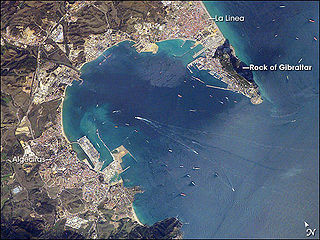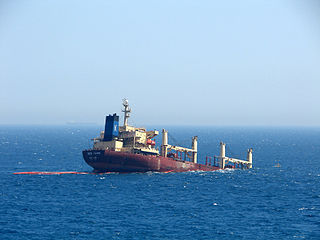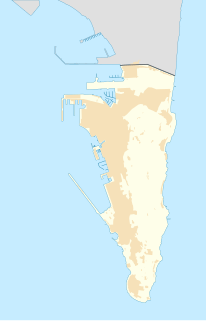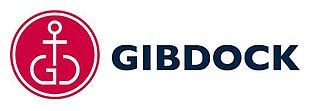The economy of Gibraltar consists largely of the services sector. While being part of the European Union, the British overseas territory of Gibraltar has a separate legal jurisdiction from the United Kingdom and enjoys a different tax system. The role of the UK Ministry of Defence, which at one time was Gibraltar's main source of income, has declined, with today's economy mainly based on shipping, tourism, financial services, and the Internet.

Fuel oil is a fraction obtained from petroleum distillation, either as a distillate or a residue. In general terms, fuel oil is any liquid fuel that is burned in a furnace or boiler for the generation of heat or used in an engine for the generation of power, except oils having a flash point of approximately 42 °C (108 °F) and oils burned in cotton or wool-wick burners. Fuel oil is made of long hydrocarbon chains, particularly alkanes, cycloalkanes and aromatics. The term fuel oil is also used in a stricter sense to refer only to the heaviest commercial fuel that can be obtained from crude oil, i.e., heavier than gasoline and naphtha.

A cargo ship or freighter ship is a merchant ship that carries cargo, goods, and materials from one port to another. Thousands of cargo carriers ply the world's seas and oceans each year, handling the bulk of international trade. Cargo ships are usually specially designed for the task, often being equipped with cranes and other mechanisms to load and unload, and come in all sizes. Today, they are almost always built by welded steel, and with some exceptions generally have a life expectancy of 25 to 30 years before being scrapped.

China Ocean Shipping (Group) Company, known as COSCO or COSCO Group, is a Chinese state-owned shipping and logistics services supplier company. Its headquarters is in Ocean Plaza in the Xicheng District in Beijing. It owns 1114 ships, including 365 dry bulk vessels, a container fleet with a capacity of 1,580,000 twenty-foot equivalent units (TEU), and a tanker fleet of 120 vessels. The fleet calls at over a thousand ports worldwide. It ranks third largest in both number of container ships and aggregate container volume in the world. In 2012, it was among China's top 15 brands.

The Bay of Gibraltar is a bay at the southern end of the Iberian Peninsula. It is around 10 km (6.2 mi) long by 8 km (5.0 mi) wide, covering an area of some 75 km2 (29 sq mi), with a depth of up to 400 m (1,300 ft) in the centre of the bay. It opens to the south into the Strait of Gibraltar and the Mediterranean Sea.

The Port of Alexandria is on the West Verge of the Nile Delta between the Mediterranean Sea and Mariut Lake in Alexandria, Egypt and is considered the second most important city and the main port in Egypt. Alexandria port consists of two harbours separated by a T-shaped peninsula. The East harbour is shallow and is not navigable by large vessels. The West harbour is used for commercial shipping. The harbour is formed by two converging breakwaters.
The Port of Algeciras is the port and harbour of Algeciras, a city located in the province of Cádiz in the autonomous community of Andalusia, Spain. It is a commercial, fishing and passenger port. It consists of numerous maritime infrastructures scattered throughout the Bay of Gibraltar. Although only the town of Algeciras and La Línea de la Concepción overlook the bay, there are port facilities in the rest of the bank, also belonging to the municipalities of San Roque and Los Barrios. It is managed along the port of Tarifa by the Port Authority of Algeciras Bay.

Tourism in Gibraltar constitutes one of the British Overseas Territory's most important economic pillars, alongside financial services and shipping. Gibraltar's main attractions are the Rock of Gibraltar and its resident population of Barbary macaques, the territory's military heritage, duty-free shopping, casinos and marinas. Although the population of Gibraltar numbers only some 30,000 people, the territory recorded nearly 12 million visits in 2011, giving it one of the highest tourist-to-resident ratios in the world.

Fuelling stations, also known as coaling stations, are repositories of fuel that have been located to service commercial and naval vessels. Today, the term "coaling station" can also refer to coal storage and feeding units in fossil-fuel power stations.

The military history of Gibraltar during World War II exemplifies Gibraltar's position as a British fortress since the early 18th century and as a vital factor in British military strategy, both as a foothold on the continent of Europe, and as a bastion of British sea power. During World War II, Gibraltar served a vital role in both the Atlantic Theatre and the Mediterranean Theatre, controlling virtually all naval traffic into and out of the Mediterranean Sea from the Atlantic Ocean.

MV New Flame was a Panamanian bulk-carrier cargo ship. It collided with an oil tanker off Europa Point, the southernmost tip of Gibraltar on 12 August 2007, and ended up partially submerged in the Strait of Gibraltar. The vessel broke into two in December 2007 amid numerous unsuccessful recovery efforts. The cargo was salvaged and the stern section removed for scrap. Following the crew's rescue, the captain was arrested for having departed without authorisation. Charges of endangering shipping were later dropped.

The Gibraltar North Mole Elbow Lighthouse is one of several lighthouses in Gibraltar, a British Overseas Territory at the south end of the peninsula of Iberia. Also known as the Gibraltar "E" Head Lighthouse, its tower is painted grey. The active lighthouse is west of the Rock of Gibraltar and positioned at the elbow of the North Mole at Gibraltar Harbour. The lighthouse is operated by the Gibraltar Port Authority.

The North Mole is a breakwater located in the northern section of Gibraltar Harbour, in the British Overseas Territory of Gibraltar, at the southern end of the Iberian Peninsula. The North Mole, with the rest of harbour, is just north of the east entrance to the Strait of Gibraltar. The breakwater was formerly known as the Commercial Mole, and is the site of the commercial port in the harbour. It was the consequence of a late nineteenth century plan by the British Admiralty to create a modern dockyard and large defensive harbour in Gibraltar.
Captain Roy Henry Stanbrook was Chief Executive of the Gibraltar Port Authority and Captain of the Port in the British Overseas Territory of Gibraltar before becoming the Harbour Master of the Port of Melbourne, Victoria in April 2014. His position prior to the 2012 appointment was that of Harbour Master for the Lower District of the Port of London Authority in the United Kingdom. He was succeeded by Gibraltarian Captain Bob Sanguinetti.

The Gibraltar Port Authority develops and manages the Port of Gibraltar.

The Gibraltar Cruise Terminal is located at the northern end of the Western Arm of the North Mole at Gibraltar Harbour. Construction of the facility in the British Overseas Territory of Gibraltar was completed in 1997. In the fifteen years since its opening, the terminal handled approximately three million cruise passengers. In May 2011, the explosion of a sullage tank on the Western Arm, while a cruise ship was berthed nearby, ultimately resulted in the loss of life of a dock worker. In October 2011, the Government of Gibraltar announced plans for expansion and renovation of the cruise terminal.

Port of Gibraltar, also known as Gibraltar Harbour, is a seaport in the British Overseas Territory of Gibraltar. It was a strategically important location during the Napoleonic Wars and after 1869 served as a supply point for ships travelling to India through the Suez Canal.
PortNews is an information-and-analytical agency PortNews IAA provides detailed on-line news and analytical materials related to Russian market of port services, sea and river transportation, shipbuilding. Special attention is paid to oil and fuel markets. Informational resource comprises exclusive branch news lines: Bunkering, Logistics, Stevedoring, Shipbuilding, and Surveyor services. All news placed at the agency’s portal are available on open access. Every day the agency’s information portal is visited by about 4,000 specialists including personnel of the Ministry of Transport, representatives of port administrations, regional authorities and regulatory agencies. Besides, PortNews IAA provides consulting, marketing, advertising and PR services.
















